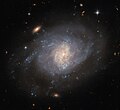File:The spiral galaxy NGC 941 photographed by the Hubble Space Telescope.jpg

Original file (3,253 × 2,992 pixels, file size: 2.85 MB, MIME type: image/jpeg)
This file is from a shared repository and may be used by other projects. The description on its file description page there is shown below.
Summary
| DescriptionThe spiral galaxy NGC 941 photographed by the Hubble Space Telescope.jpg |
English: This image features the spiral galaxy NGC 941, which lies about 55 million light-years from Earth. The data used for this image were collected by Hubble’s Advanced Camera for Surveys (ACS). The beautiful NGC 941 is undoubtedly the main attraction in this image; however, this hazy-looking galaxy was not the motivation for the data being collected. That distinction belongs to an astronomical event that took place in the galaxy years before: the supernova SN 2005ad. The location of this faded supernova was observed as part of a study of multiple hydrogen-rich supernovae, also known as type II supernovae, in order to better understand the environments in which certain types of supernovae take place. Whilst the study was conducted by professional astronomers, SN 2005ad itself owes its discovery to a distinguished amateur astronomer named Kōichi Itagaki, who has discovered over 170 supernovae.
This might raise the question of how an amateur astronomer could spot something like a supernova event before professional astronomers — who haveaccess to telescopes such as Hubble. The answer is in part that the detection of supernovae is a mixture of skill, facilities and luck. Most astronomical events happen over time spans that dwarf human lifetimes, but supernova explosions are extraordinarily fast, appearing very suddenly and then brightening and dimming over a period of days or weeks. Another aspect is that professional astronomers often do not spend that much time actually observing. There is a great deal of competition for time on telescopes such as Hubble, and then data from a few hours of observations might take weeks, months, or sometimes even years to process and analyse to their full potential. Amateur astronomers can spend much more time actually observing the skies, and sometimes have extremely impressive systems of telescopes, computers and software that they can put to use. So many supernovae are spotted by skilful amateurs such as Itagaki that there is actually an online system set up for reporting them (the Transient Name Server). This is a big help to professional astronomers, because with supernova events time is truly of the essence. After the discovery of SN 2005ab was reported, professional astronomers were able to follow up with spectroscopic studies and confirm it as a type II supernova, which eventually led to its location being included in this study with Hubble. Such a study wouldn’t be possible without a rich library of previous supernovae, built with the keen eyes of amateur astronomers. [Image Description: A spiral galaxy, seen face-on from Earth. The spiral arms of the galaxy are bright but not well defined, merging into a swirling disc with a faint halo of dimmer gas around it. The core glows brightly in a lighter colour and has a bit of faint dust crossing it. Two redder,visually smaller galaxies and a bright star are prominent around the galaxy, with more tiny objects in the background.] |
| Date | |
| Source | https://esahubble.org/images/potw2345a/ |
| Author | ESA/Hubble & NASA, C. Kilpatrick |
Licensing
| Public domainPublic domainfalsefalse |
| This file is in the public domain in the United States because it was solely created by NASA. NASA copyright policy states that "NASA material is not protected by copyright unless noted". (See Template:PD-USGov, NASA copyright policy page or JPL Image Use Policy.) |  | |
 |
Warnings:
|
Captions
image/jpeg
File history
Click on a date/time to view the file as it appeared at that time.
| Date/Time | Thumbnail | Dimensions | User | Comment | |
|---|---|---|---|---|---|
| current | 00:51, 6 November 2023 |  | 3,253 × 2,992 (2.85 MB) | imagescommonswiki>Phantomdj | Uploaded a work by ESA/Hubble & NASA, C. Kilpatrick from https://esahubble.org/images/potw2345a/ with UploadWizard |
File usage
The following file is a duplicate of this file (more details):
- File:The spiral galaxy NGC 941 photographed by the Hubble Space Telescope.jpg from Wikimedia Commons
The following page uses this file:
Metadata
This file contains additional information, probably added from the digital camera or scanner used to create or digitize it.
If the file has been modified from its original state, some details may not fully reflect the modified file.
| Image title |
|
|---|---|
| Date and time of data generation | 06:00, 6 November 2023 |
| Software used | Adobe Photoshop 25.0 (Windows) |
| File change date and time | 01:29, 31 October 2023 |
| Date and time of digitizing | 11:32, 27 June 2023 |
| Date metadata was last modified | 02:29, 31 October 2023 |
| Source | ESA/Hubble |
| Credit/Provider | ESA/Hubble & NASA, C. Kilpatrick |
| Unique ID of original document | xmp.did:19d570a9-7795-944d-bcfc-495fb29f9b7a |
| Short title |
|
| Keywords | NGC 941 |
| Contact information |
ESA Office, Space Telescope Science Institute, 3700 San Martin Dr Baltimore, MD, 21218 United States |
| Usage terms |
|
| IIM version | 4 |
